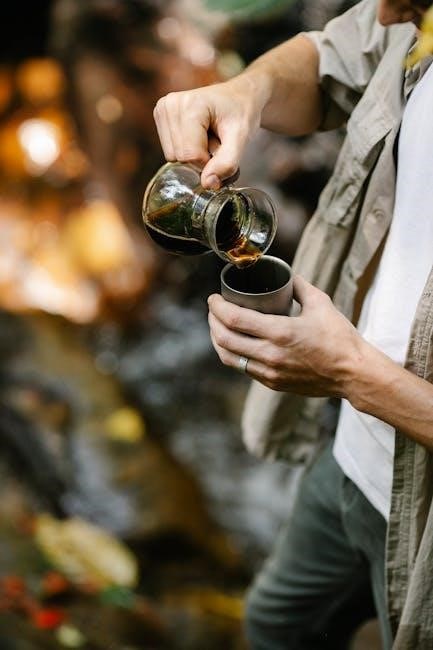chemex pour over instructions
Unlock coffee nirvana! Our Chemex pour over instructions make brewing delicious, smooth coffee easy. Get the perfect cup every time with our simple guide!
What is Chemex?
The Chemex‚ a timeless brewer since 1941‚ merges art and science to produce refined coffee. Its iconic hourglass shape delivers a clean cup‚ extracting only essential flavors for a nuanced‚ personal brew. It’s simple to use but requires attention to detail.
Chemex Brewing Supplies
To brew with a Chemex‚ you’ll need specific supplies for a quality brew. This includes a Chemex brewer‚ Chemex filters‚ a burr grinder (recommended)‚ a digital scale‚ and a pouring kettle for controlled water pouring.
Chemex Brewer
The Chemex brewer‚ recognized for its elegant‚ one-piece hourglass design‚ is central to the pour-over method. Crafted from non-porous borosilicate glass‚ it ensures a clean‚ sediment-free cup by not imparting any flavors of its own. Available in various sizes‚ it suits both individual servings and larger batches for sharing. Its design isn’t just aesthetically pleasing; it’s functional‚ allowing for optimal extraction and temperature stability during brewing.
The Chemex’s unique construction requires specific filters‚ which are thicker than standard paper filters‚ contributing to its signature clean taste. Mastering the Chemex involves understanding how its design affects the brewing process‚ from water flow to heat retention. Its simple design and ease of use make it an approachable tool for both beginners and experienced coffee enthusiasts.
Chemex Filters
Chemex filters are essential for achieving the brewer’s signature clean cup. These filters‚ crafted from thick paper‚ are designed to remove oils and sediments‚ resulting in a smooth‚ grit-free brew. Available in pre-folded squares or circles‚ they require proper folding and placement within the Chemex brewer.
The filter’s thickness affects the flow rate and extraction‚ so using genuine Chemex filters is recommended for optimal results. Pre-wetting the filter before brewing removes any paper taste and helps it adhere to the brewer’s walls. Different filter types exist‚ including bleached and unbleached options‚ each subtly influencing the final flavor profile. Experimenting with different folding techniques can also impact the brew time and extraction. Ultimately‚ the Chemex filter plays a vital role in producing a balanced and refined cup of coffee.
Coffee Grinder (Burr Grinder Recommended)
A quality coffee grinder is crucial for a great Chemex brew. Burr grinders are highly recommended over blade grinders because they produce a consistent grind size. Consistent grind size leads to even extraction‚ preventing bitter or sour flavors. A blade grinder‚ on the other hand‚ chops the beans unevenly‚ resulting in inconsistent extraction and a muddier taste.
For Chemex‚ a medium-coarse grind‚ resembling sea salt‚ is ideal. This allows for proper water flow and avoids over-extraction. Adjust your grind size based on your taste and brew time. Finer grinds slow the brew and can lead to bitterness‚ while coarser grinds can result in a weak‚ sour cup. Investing in a good burr grinder significantly elevates the quality and consistency of your Chemex coffee.
Digital Scale
Precision is key when brewing Chemex‚ and a digital scale is essential for achieving accurate measurements. A digital scale allows you to precisely measure both coffee grounds and water‚ ensuring the correct brew ratio. The recommended ratio is generally 1:15 (coffee to water)‚ but can vary based on preference.
Using a scale eliminates guesswork and helps you reproduce consistent‚ delicious results every time. Tare the scale with the Chemex on top to zero it out before adding coffee. Then‚ weigh your coffee beans and grind them. Place the Chemex back on the scale after adding the filter‚ and tare again before beginning the bloom. Continue weighing water throughout the brewing process to maintain the desired ratio. A digital scale is a small investment that yields significant improvements in brew consistency and flavor.
Pouring Kettle
A pouring kettle‚ ideally with a gooseneck spout‚ is crucial for controlled water flow during the Chemex brewing process. The gooseneck design allows for a slow‚ steady‚ and precise pour‚ which is essential for even saturation of the coffee grounds and optimal extraction. Precise pouring prevents channeling‚ where water bypasses the coffee grounds‚ leading to under-extraction.
Heat your filtered water to the correct temperature (201-205°F) in the kettle. The controlled pour allows you to evenly wet the grounds during the bloom phase and maintain a consistent flow throughout the brewing process. This ensures all grounds are saturated‚ resulting in a balanced and flavorful cup. The kettle gives you the best control for the perfect flavor extraction.
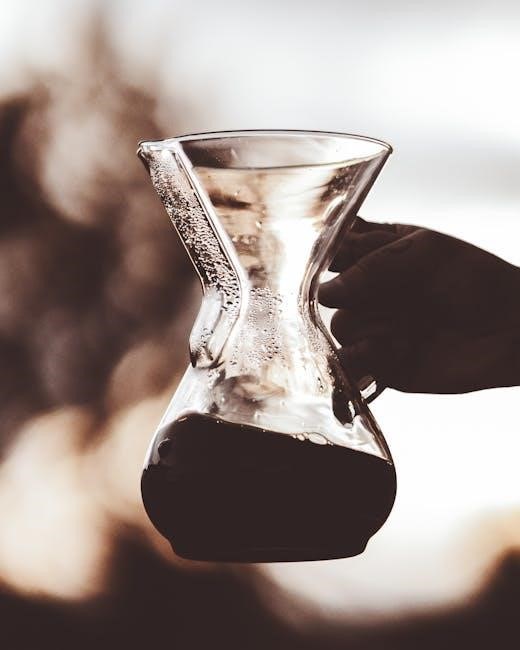
Chemex Brew Ratio
The Chemex brew ratio is a fundamental aspect of achieving a balanced and flavorful cup of coffee. A recommended starting point is a 1:15 ratio‚ meaning 1 gram of coffee for every 15 grams of water. For example‚ to brew a 12oz (approximately 350g) mug‚ you would use 20 grams of coffee.
This ratio can be adjusted to taste‚ but maintaining consistency is key. Using a digital scale ensures accuracy. A stronger brew can be achieved by using a ratio closer to 1:14 or 1:13‚ while a weaker brew can be achieved with a ratio closer to 1:16 or 1:17. Dial in your personal preferences by experimenting‚ always keeping the ratio in mind. It should stay constant for the best results.
Grind Size for Chemex
Achieving the correct grind size is crucial for a successful Chemex brew. The ideal grind size for Chemex is generally considered medium-coarse. This means the coffee grounds should resemble small flakes of freshly ground sea salt or coarse table salt. A burr grinder is highly recommended for achieving a consistent and uniform grind‚ allowing for even extraction.
If the grind is too fine‚ the water will flow too slowly through the grounds‚ leading to over-extraction and a bitter taste. Conversely‚ if the grind is too coarse‚ the water will flow too quickly‚ resulting in under-extraction and a sour‚ weak cup of coffee. Adjust the grind size based on your taste. If faster‚ grind finer; if slower‚ grind coarser.
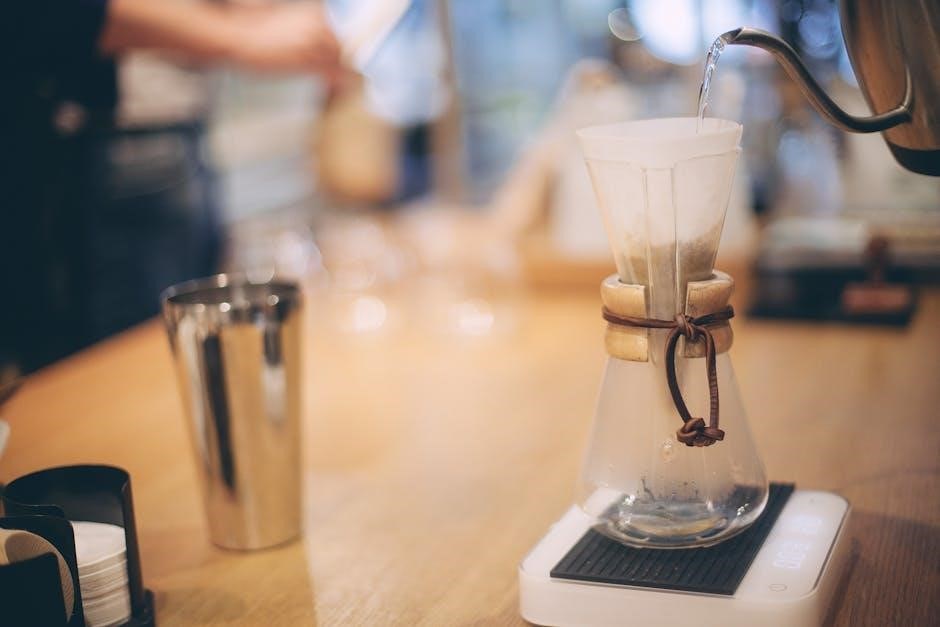
Water Temperature
Water temperature plays a pivotal role in extracting the optimal flavors from your coffee grounds during the Chemex brewing process. The ideal water temperature for Chemex brewing typically falls between 201-205°F (94-96°C). This temperature range allows for proper extraction without scalding the coffee‚ resulting in a balanced and flavorful brew.
Using a kettle with a built-in thermometer or a separate thermometer is recommended to ensure accurate temperature control. If you don’t have a thermometer‚ bring the water to a boil and then let it sit for about 45-60 seconds before pouring. Too hot water can lead to bitter coffee‚ while water that is too cool can result in sour or weak coffee.
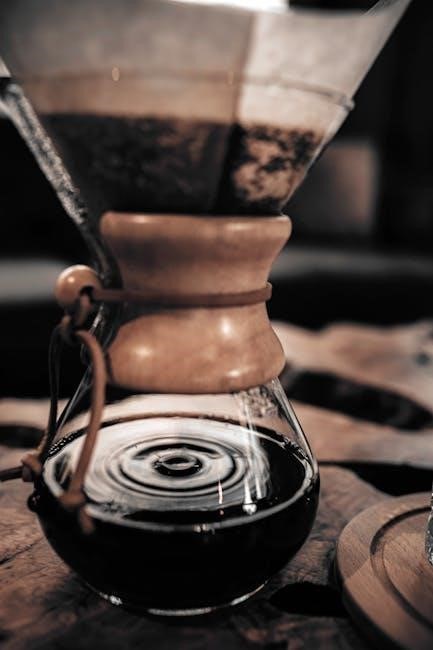
Chemex Brewing Steps
Mastering the Chemex involves key steps: rinsing the filter‚ the bloom‚ and a careful pouring technique. These steps guarantee a clean‚ nuanced cup every time. Time and your personal touch will elevate the experience.
Rinsing the Filter
Before brewing‚ thoroughly rinsing the Chemex filter is a crucial step often overlooked. Place the filter in the Chemex‚ ensuring the layered side faces the spout. Saturate the filter with hot‚ filtered water‚ allowing it to adhere snugly to the brewer’s walls‚ creating a nice seal.
This pre-wetting serves a dual purpose. First‚ it eliminates any unwanted paper taste that might otherwise taint the final brew. Second‚ it preheats the Chemex glass‚ maintaining temperature consistency during brewing. Discard the rinse water after saturation to avoid unwanted flavors.
By removing any paper taste‚ a clean brewing environment is made. The heated glass helps prevents cooling too soon. The filter is now ready to receive the coffee grounds‚ ensuring a pure and flavorful extraction. It is a simple process but crucial.
The Bloom
After rinsing the filter‚ it’s time for the bloom; This initial wetting of the coffee grounds is essential for releasing trapped gases‚ primarily carbon dioxide‚ which can hinder proper extraction and impact the coffee’s flavor. Ensure the Chemex is on a digital scale and tare to zero before adding your ground coffee.
Start your timer‚ and gently pour roughly twice the amount of water to coffee (for example‚ 60 grams of water for 30 grams of coffee) evenly over the grounds‚ saturating them completely. You will notice the coffee “bloom” or puff up as the gases escape.
Allow the coffee to bloom for around 30-45 seconds. This allows the gases to fully release and prepares the grounds for an even extraction. Once the bloom subsides‚ you’re ready to continue pouring‚ unlocking the full potential of your coffee beans.
Pouring Technique
The pouring technique is critical to a balanced Chemex brew. After the bloom‚ begin pouring slowly and deliberately‚ using a circular or spiraling motion. Aim to saturate all the grounds evenly‚ avoiding pouring directly in the center or around the edges of the filter.
Maintain a steady flow‚ and don’t let the water level rise too close to the rim of the Chemex. If it does‚ pause briefly to allow the water to drain before continuing. This prevents grounds from escaping and ensures a cleaner cup.
As you pour‚ observe the coffee bed. You want to maintain a consistent slurry‚ avoiding channeling (where water flows through the grounds too quickly in certain areas). Adjust your pouring speed and pattern as needed to achieve an even extraction. A slow‚ controlled pour is key to unlocking the full flavor of your coffee.
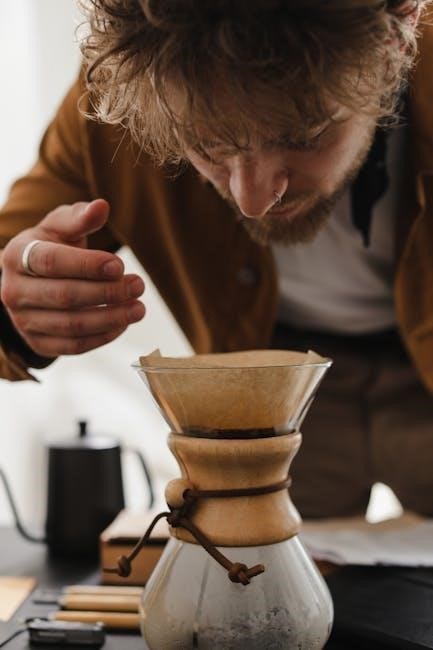
Brew Time
Brew time is a crucial factor in achieving the desired extraction and flavor profile with your Chemex. Aim for an overall brew time of approximately 4 to 6 minutes. This timeframe allows for proper saturation‚ bloom‚ and extraction of the coffee grounds‚ resulting in a balanced and flavorful cup.
Several factors can influence your brew time‚ including grind size‚ water temperature‚ and pouring technique. A coarser grind will generally result in a faster brew time‚ while a finer grind will slow it down. Similarly‚ hotter water can speed up the extraction process. Consistent pouring helps regulate the flow.
Monitor the draw-down time (the time it takes for the water to filter through the grounds) and adjust your technique as needed. If the brew is too fast‚ try a finer grind or a slower pour. If it’s too slow‚ coarsen the grind or adjust the pouring. Experiment to find the sweet spot for your preferred taste.

